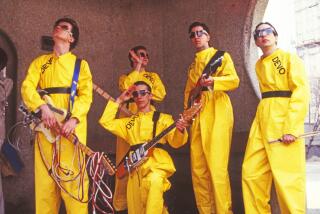Trying (in Vain?) to Stir Up Controversy
- Share via
Controversy is a scarce commodity in rock and rap these days. Marilyn Manson can don prosthetic breasts, Ol’ Dirty Bastard can bum-rush the Grammys and Scott Weiland can sing about getting high, and it hits pop audiences with a dull thud rather than a norm-shattering resonance.
But controversy is directly proportional to the excitement or edginess of its source. In other words, since there is no new counterculture following punk, rap, psychedelia, etc. to spawn against-the-grain activity (middle-class revolt, inner-city strife, antiwar agitation) there’s no real substance behind the stunt of the moment. The currently complacent social climate helps keep this musical patch dull--there’s no economic crisis to rail against, no impoverished living conditions that haven’t been exploited and marketed, no amount of violence that hasn’t been reenacted five times an hour on TV.
So in this month’s Sound & Vision, where music videos are rated on a scale of 0-100, we search for clips that have stirred up controversy (either deliberately or unwittingly), or are aiming to do so. Shock or schlock, that is the question.
George Michael, “Outside,” directed by Vaughan Arnell. Using a public restroom as the opening set for this video, Michael plays off his arrest last April for lewd conduct in a Beverly Hills facility. In the unedited version of this video, sailors, construction workers, office employees and teenagers partake in sex (both straight and gay) in such public places as the back of a dump truck, a high-rise office building and a gymnasium locker room, while police try their damnedest to stop them. The funniest sequence: The dingy men’s room becomes a glitzy nightclub, complete with disco balls and sequined urinals, giving Michael and a troupe of dancing cops a stage for some steamy choreography. Ending the video with a kiss between two policemen, the singer not only makes fun of himself, but also jabs at the powers-that-be for trying to quash something that’s “human nature.” 98
Alanis Morissette, “Thank U,” directed by Stephane Sednaoui. Morissette has never been so vulnerable as in her new video, where she appears totally naked in very public places. No cops arrest her, and no disco balls drop from the sky. Instead, passersby on the busy city streets and subways where she stands occasionally stop and touch her in the way a worshiper touches an icon of purity or spirituality. It’s a visual metaphor for stripping down to one’s raw essence, and in keeping with the theme, Morissette makes no attempts to airbrush her real-girl body (complete with stomach and hips). This has caused much debate about the video--from those disturbed by her nakedness to those disparaging of her non-augmented physique to those championing Morissette for her courage. 89
Cardigans, “My Favorite Game,” directed by Jonas Akerlund. In the original, unedited version, singer Nina Persson places a rock on the gas pedal of her old Cadillac convertible and drives recklessly through the desert, running cars and pedestrians off the road and causing many explosive wrecks. She stands up and assumes a Christlike pose before ramming head-on into a van full of her bandmates, and wakes up on the pavement only to be struck in the head by that rock. MTV airs the edited version (a nice Sunday cruise in comparison) because, according to MTV, the original may be a bad influence. Can anyone say Lil’ Kim, “Celebrity Death Match,” “Spring Break” . . . ? 85
UNKLE, “Rabbit in Your Headlights,” directed by Jonathan Glazer. Far more brutal than the Cardigans’ video. A disheveled, mumbling homeless man walks down the middle of a tunnel, concentrating on his monologue as cars initially swerve to miss him, then begin to graze him and knock him over. Against the eerie ballad (sung by Radiohead’s Thom Yorke), the man is flipped by speeding autos and run over by unaffected drivers. He finally stops walking, strips off his bloody jacket and lets himself be hit straight on by a car that then bursts into a thousand pieces. A harsh, graphic depiction of apathy, denial and, finally, redemption. 81
More to Read
The biggest entertainment stories
Get our big stories about Hollywood, film, television, music, arts, culture and more right in your inbox as soon as they publish.
You may occasionally receive promotional content from the Los Angeles Times.











